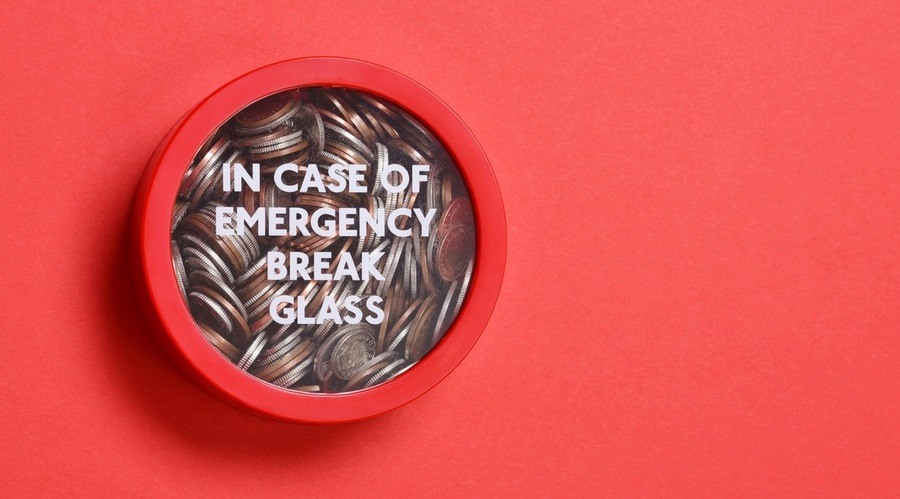There’s no getting around the fact that we all need to successfully build an emergency fund, regardless of how much or how little money we make. Everyone encounters financial setbacks, burdens, and hardships, and they often come when we least expect it. Having something set aside just for those unexpected set-backs can make life much easier.
It can be hard to successfully build an emergency fund – and by successful, I mean not tapping into it for things that aren’t emergencies. When you use your emergency fund to cover living expenses or other expected costs, you are taking away from money that can help when a true emergency comes up. I want to walk through the best approach for establishing your emergency fund. No matter where you stand financially, an emergency fund is a necessity.
Steps to successfully build an emergency fund
#1 Assess Your Situation
The best emergency fund you can have is one that contains 3-6 months’ worth of living expenses. This is in conjunction with other forms of saving. You never touch your emergency fund, unless a true emergency (think job loss, car accident, or unexpected moving expenses) comes up. However, if you have debt, can’t control your spending, or don’t make much money, it can be hard to imagine saving 3-6 months’ worth of anything.
If your primary focus is to pay down debt, you do need to successfully build an emergency fund. The amount just differs. Since debt can be very expensive, the time you take to save 3-6 months’ worth of expenses can cost you a lot in interest. Instead, your goal should be to save $1000 before aggressively tackling your debt. This amount is large enough to handle minor setbacks but small enough to make it somewhat reachable.
Does saving money seem hard because you’re living paycheck to paycheck? The true issue here may be a lack of spending control, not a lack of income. A budget will do wonders. Your budget will show you how much money you have left after all of your expenses. If the amount looks right but seems high, the culprit may be discretionary spending. Go on a spending fast to see where you truly stand once your expenses are covered. Lastly, your budget will show you what the 3-6 months’ worth amount is. Now you have a goal to start working towards!
#2 Create a New Savings Account
After you have decided how much you need to save for your emergency fund, you need to create a new savings account. Why a new one? Well, whatever savings accounts you currently have either aren’t working for you, or haven’t housed any form of emergency savings. You don’t want to use a savings account that you constantly tap into because you are already in the habit of doing so. You want to start fresh.
A new account, preferably at a new bank, allows you to start the habit of saving for emergencies and not touch it. If your account is at a different bank than your current checking and savings, it will be harder to get to if you are tempted to use that money. One of the best routes to go is an online savings account. The savings accounts offered at online banks come with the best interest rates around. Since you won’t be touching your money, and it will be growing, why not make more in interest?
If you decide that an online savings account isn’t for you, that’s fine. The goal should still be to open a new account, at a new bank. Make sure that whatever bank you choose, you aren’t paying any fees. Confirm there are no minimum balance requirements, at least initially. You don’t want your emergency fund to be eaten up by fees. You also don’t want your money to be tied up in investments or CDs, which can be hard to get to if an emergency does come up out of the blue.
#3 Start Saving and Automate
Now that you know your savings goal amount and you’ve opened your new savings account, it’s time to start saving. You will want to refer back to your budget to see what you can reasonably afford to save without touching. You don’t want to over-estimate your savings then be forced to take it out because of proper planning.
Do you want to save monthly or each paycheck? Whatever monthly amount you can reasonably afford to save, divide by 2 if you are paid bi-weekly. Divide it by 4 if you are paid weekly. Once you have the correct amount per paycheck, set up a direct deposit. Avoid the temptation of touching your money by having it taken directly from your paycheck and put into savings. This will also make you feel like you aren’t missing anything, since you never had the opportunity to see the money.
If your employer doesn’t offer direct deposit, then consider setting up automatic transfers from your checking to your savings on the day you get paid. Unfortunately, you will see the money leaving your bank account, but over time you will become accustomed to the transfer. Before you know it, the move from checking to savings won’t phase you one bit!
#4 Think About Saving More
Steps 1-3 are great, especially if you are just getting started on your emergency fund savings journey, but how can you reach your goal faster? We all know that saving for multiple goals at the same time can be done, but having an emergency fund should take precedent over all other goals. The sooner you can save your goal amount in your emergency fund, the sooner you can focus on something else.
Once you’ve gotten into the hang of contributing to your emergency fund and not touching it, do another sweep of your budget. Are there any expenses or subscriptions you can get rid of? If you don’t need it or aren’t using it, get rid of it! Next, move on to the discretionary spending. This can always be adjusted because most of the time, it’s not a necessity. Think about why you shouldn’t indulge in your “wants” right now – because once you reach your goal, you’ll have more money available to do the things you want without worry of an unexpected setback.
#5 Don’t Beat Yourself Up if You Need to Use it
When you do have money saved specifically for emergencies, don’t beat yourself up if you need to use it for an emergency. That’s exactly what it’s there for. Of course, it can feel like all of your savings progress was taken away in one instant, but imagine if you didn’t have anything saved. You would likely resort to using credit cards to cover the emergency – which makes your situation worse.
Be grateful that you had an emergency fund to use, and focus your savings efforts on building it up again. At least you can see that it really did come in handy.
There are plenty of strategies to save smarter, save more, and save easier, regardless of what you’re saving for. If you want to learn how to become a successful saver, I highly recommend the CGS course Money Management Mastery. All of the tools, tips, tricks, and knowledge learned in the course can help make saving for anything much easier. Everything that works for me when it comes to saving is shared with you!
Do you currently have any money saved for emergencies? What experiences can you share about handling financial setbacks and using (or not using) a form of savings to help? I want to hear about your journey, so leave a comment below to share!






2 thoughts on “How to Successfully Build an Emergency Fund”
I have an emergency fund usually around $2,000 (still paying off debt) and it’s recently been used to buy my mom a flight and cover her expenses to where my grandma passed away. My grandma is being cremated and then brought back to where we live for the funeral. I might have used it for my mom, but this was an unexpected life event that occurred where I was glad I was able to help my parents as they didn’t have room on any of their cards to book the flight. Due to a number of Murphy’s happening this year, their savings had already been depleted. My mom was very close to her mom and I know that my mom not being able to say goodbye in person would have weighed on her heart for the rest of her life. This has made me thankful for being on this debt free journey. Being able to give in times like these is what life is about. I can always earn that money back. I can’t earn back the short window of time to allow my mom to say goodbye to my grandma no matter how much I earn.
Thank you for sharing that Kate. I’m sorry for your loss but so happy to hear that because of your emergency fund, you were able to step in and help your family. Keep doing what you’re doing!